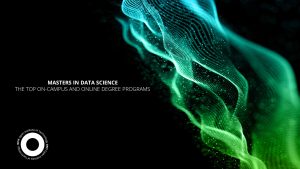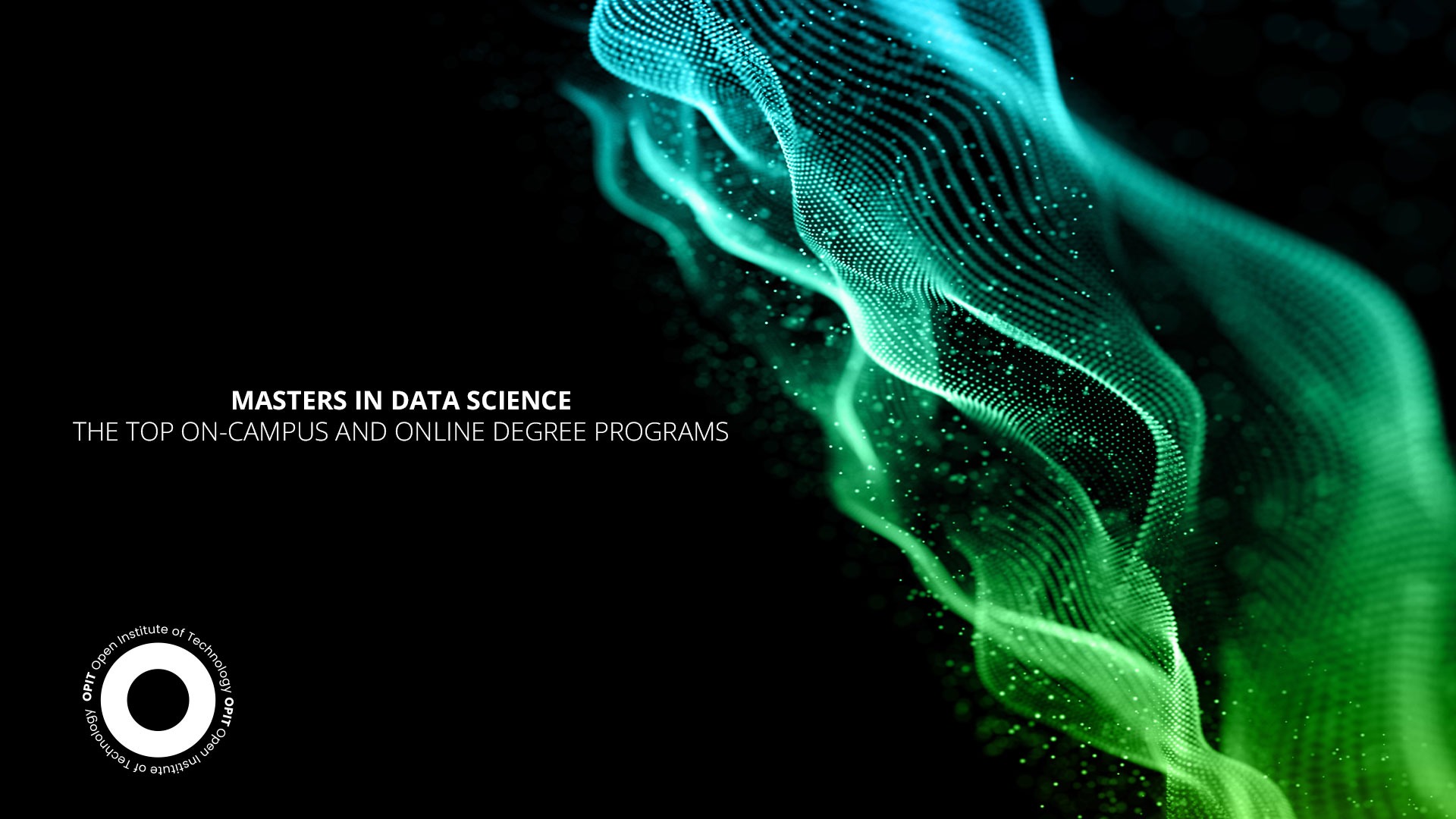

As a data scientist, you bridge the gap between the data a company collects and the actionable insights that the company must extract from this data to succeed. That’s reflected in the salary you can command, with Glassdoor showing us that the average salary in Germany for a data scientist is €63,500, with the potential to hit the €80,000 range.
But you can’t turn up at a company and simply proclaim yourself a data scientist. You need to master the analytical and algorithmic tools data scientists use, along with a solid foundation in the AI technologies pervading the data science space now and in the future. An MSc data science program helps you develop those skills, and this article looks at four of the best (two each for on-campus and online programs) to consider.
Factors to Consider When Choosing a Data Science Master’s Program
Before taking the plunge and applying for a data science Master course, you need to get your feet wet with a little research. Consider the following factors, ranging from the course’s content to its ability to help you land a job.
Program Reputation
A good reputation, both for the program and the institution that provides it, can make the difference between getting a call for an interview or having your CV end up in the trash. Look for accredited universities that deliver courses with provable results.
Curriculum
While everyone who studies for a Master’s in data science has the main goal of being a data scientist, the area you wish to work on impacts your decision. Check the course curriculum to ensure you’re getting what you need on the theoretical, practical, and specific industry levels to make the course worthwhile.
Faculty Expertise and Research Opportunities
Any qualification you earn is only as good as the people behind the course providing that qualification. For a Master’s degree, look for faculty that has demonstrable industry experience, a solid track record of teaching, and the ability to provide research opportunities you can use to beef up your CV.
Industry Connections
As nice as the piece of paper you get upon completing a degree may be, what’s nicer is when that piece of paper comes from a course that gets you directly into a career. Look for established industry connections with big players and an alumni network filled with students who’ve gone on to work in the types of roles that appeal to you.
Program Duration and Flexibility
Life often gets in the way of education. Having commitments to work, family, and personal endeavors can make a full-time course unfeasible. Look for a course that fits around your schedule, whatever that may be, and offers enough flexibility for you to commit time when you can.
Top On-Campus MSc Data Science Programs
Being on campus during your studies gives you a chance to participate in a university’s research projects in person. Plus, you’ll work directly with faculty and meet peers who share your passion for data science and may have a few entrepreneurial ideas for you to latch on to. These are the two best data science Master course options for those who want the on-campus experience.
Master’s in Data Science (ETH Zurich)
Developed by an institution that consistently ranks as one of the world’s top 10 providers of computer science education, this course combines theory with practice. You’ll learn about the concepts underpinning data science and how those concepts apply to industries as diverse as medicine, finances, and environmental research. But the true standout is ETH Zurich’s Data Science Laboratory, where you’ll put your theoretical knowledge into practice by experimenting with real-world data science problems.
The course is delivered in English, meaning you must provide a certificate of English language proficiency at level C1 or higher to apply. Assuming you meet the language requirements, you’ll also need a BSc (or equivalent) offering at least 180 ECTS credits in a technical subject, such as computer science, physics, or math. You’ll pay CHF 730 (approx. €749) per semester for the two-year course, with the program taking no more than eight semesters to complete. Hitting the minimum four semesters means you pay about €2,996 in total, depending on the CHF-to-euro exchange rate.
Master of Science in Data Science (University College London)
University College London (UCL) offers a choice between a one-year full-time program and a two-year part-time program, with international students usually paying more than UK-based students. You need to shell out £38,300 (approx. €44,000) for this Master’s in data science. The course may seem expensive for those on a budget, though help is offered through UCL’s Financial Assistance Fund for Postgraduate Students. You’ll only get access to this fund if you can demonstrate that you’re in financial hardship and have taken all available provisions (such as applying for a student loan) available to escape that hardship.
Moving away from the unpleasantness of such high tuition fees, UCL delivers a data science program that starts with the basic theory of machine learning and ends with a research project to demonstrate your knowledge. Admission is tough – the university received 20 applications per available place in 2022. But you get a degree with accreditation from the Royal Society of Statistics if you’re willing to invest the money and are a proven high-performer in a technical subject.
Online and Part-Time MSc Data Science Programs
An online data science Master degree usually comes with two advantages over on-campus options – lower fees and more flexibility. These two courses stand out in the online space.
Master in Applied Data Science & AI (OPIT)
It’s the word “applied” that makes OPIT’s Master’s program stand out as it tells you that you’re going to learn so much more than basic theory in this course. That’s not to say you won’t learn theory, with topics like AI, machine learning, and problem-solving practices all on the docket in the first term of this 18-month course. But the second term challenges you to put all of that knowledge to the test by confronting you with real-world problems, followed by a third term that offers either an internship or an in-depth project.
Tuition fees vary depending on when you apply for the course. You’ll spend €6,500 when paying the full price, though early birds can get on board for €4,950, saving over €1,500 in the process. There’s also an option for a fast-tracked 12-month course (the same tuition fees apply) for people who can dedicate a little more time per week to their education. As for admissions, a BSc degree in almost any field is enough for you to get through the basic entry criteria. International students must demonstrate English language proficiency up to the B2 level, and OPIT has its own English certification program to help with that.
Master of Science in Applied Data Science (University of Southern California Online)
With the online version of its Master’s in data science program, the University of Southern California (USC) makes a top-class education available to European and international students. The selling point is simple – equip you with the skills you need to work as a data scientist. To do that, the course starts with the basics of Python and how to use this popular programming language to navigate your way through complex datasets. As you progress, you’ll face more real-world problems in data management and visualization that echo those you’ll find in industry.
The online program is offered as a full-time two-year course or part-time three-year version, and you can expect to pay $2,424 (approx. €2,240) per credit unit. A successful applicant will usually have a BSc in an engineering-related course, or one in computer science, math, statistics, or a similar numbers-centric field.
Tips for a Successful Application to a Top MSc Data Science Program
Maybe you’ve found the perfect Master’s in data science among the four in this article, or you have your eye on a different course entirely. Either way, you have a hurdle to jump – the application process. Follow these tips to craft an application that increases your chances of being the student who gets chosen from applicant pools that can number in the hundreds.
- Craft a strong personal statement to show your university of choice who you are as a person away from whatever accomplishments you list on your CV.
- Get recommendations from appropriate people (ideally previous teachers or employers in data science-related fields) to show you have people who can vouch for you.
- Demonstrate relevant work experience wherever you can (internships are your friend) or showcase academic projects related to data science.
- Spend time preparing for interviews by learning as much as possible about the interviewer and their process.
- Ensure you meet the minimum requirements regarding English language proficiency and previous degree-level experience.
Online or Off – Find the Data Science Master Degree That Works for You
By pursuing a data science Master course, you set off on a journey that prepares you for a future where Big Data (and the models that parse through that data) are king. Each of the four programs here prepares you for that future, albeit in different ways, and each puts you in line for a career that averages in the high five figures and has the potential to grow even further.
Related posts

Source:
- Agenda Digitale, published on November 25th, 2025
In recent years, the word ” sustainability ” has become a firm fixture in the corporate lexicon. However, simply “doing no harm” is no longer enough: the climate crisis , social inequalities , and the erosion of natural resources require a change of pace. This is where the net-positive paradigm comes in , a model that isn’t content to simply reduce negative impacts, but aims to generate more social and environmental value than is consumed.
This isn’t about philanthropy, nor is it about reputational makeovers: net-positive is a strategic approach that intertwines economics, technology, and corporate culture. Within this framework, digitalization becomes an essential lever, capable of enabling regenerative models through circular platforms and exponential technologies.
Blockchain, AI, and IoT: The Technological Triad of Regeneration
Blockchain, Artificial Intelligence, and the Internet of Things represent the technological triad that makes this paradigm shift possible. Each addresses a critical point in regeneration.
Blockchain guarantees the traceability of material flows and product life cycles, allowing a regenerated dress or a bottle collected at sea to tell their story in a transparent and verifiable way.
Artificial Intelligence optimizes recovery and redistribution chains, predicting supply and demand, reducing waste and improving the efficiency of circular processes .
Finally, IoT enables real-time monitoring, from sensors installed at recycling plants to sharing mobility platforms, returning granular data for quick, informed decisions.
These integrated technologies allow us to move beyond linear vision and enable systems in which value is continuously regenerated.
New business models: from product-as-a-service to incentive tokens
Digital regeneration is n’t limited to the technological dimension; it’s redefining business models. More and more companies are adopting product-as-a-service approaches , transforming goods into services: from technical clothing rentals to pay-per-use for industrial machinery. This approach reduces resource consumption and encourages modular design, designed for reuse.
At the same time, circular marketplaces create ecosystems where materials, components, and products find new life. No longer waste, but input for other production processes. The logic of scarcity is overturned in an economy of regenerated abundance.
To complete the picture, incentive tokens — digital tools that reward virtuous behavior, from collecting plastic from the sea to reusing used clothing — activate global communities and catalyze private capital for regeneration.
Measuring Impact: Integrated Metrics for Net-Positiveness
One of the main obstacles to the widespread adoption of net-positive models is the difficulty of measuring their impact. Traditional profit-focused accounting systems are not enough. They need to be combined with integrated metrics that combine ESG and ROI, such as impact-weighted accounting or innovative indicators like lifetime carbon savings.
In this way, companies can validate the scalability of their models and attract investors who are increasingly attentive to financial returns that go hand in hand with social and environmental returns.
Case studies: RePlanet Energy, RIFO, and Ogyre
Concrete examples demonstrate how the combination of circular platforms and exponential technologies can generate real value. RePlanet Energy has defined its Massive Transformative Purpose as “Enabling Regeneration” and is now providing sustainable energy to Nigerian schools and hospitals, thanks in part to transparent blockchain-based supply chains and the active contribution of employees. RIFO, a Tuscan circular fashion brand, regenerates textile waste into new clothing, supporting local artisans and promoting workplace inclusion, with transparency in the production process as a distinctive feature and driver of loyalty. Ogyre incentivizes fishermen to collect plastic during their fishing trips; the recovered material is digitally tracked and transformed into new products, while the global community participates through tokens and environmental compensation programs.
These cases demonstrate how regeneration and profitability are not contradictory, but can actually feed off each other, strengthening the competitiveness of businesses.
From Net Zero to Net Positive: The Role of Massive Transformative Purpose
The crucial point lies in the distinction between sustainability and regeneration. The former aims for net zero, that is, reducing the impact until it is completely neutralized. The latter goes further, aiming for a net positive, capable of giving back more than it consumes.
This shift in perspective requires a strong Massive Transformative Purpose: an inspiring and shared goal that guides strategic choices, preventing technology from becoming a sterile end. Without this level of intentionality, even the most advanced tools risk turning into gadgets with no impact.
Regenerating business also means regenerating skills to train a new generation of professionals capable not only of using technologies but also of directing them towards regenerative business models. From this perspective, training becomes the first step in a transformation that is simultaneously cultural, economic, and social.
The Regenerative Future: Technology, Skills, and Shared Value
Digital regeneration is not an abstract concept, but a concrete practice already being tested by companies in Europe and around the world. It’s an opportunity for businesses to redefine their role, moving from mere economic operators to drivers of net-positive value for society and the environment.
The combination of blockchain, AI, and IoT with circular product-as-a-service models, marketplaces, and incentive tokens can enable scalable and sustainable regenerative ecosystems. The future of business isn’t just measured in terms of margins, but in the ability to leave the world better than we found it.

Source:
- Raconteur, published on November 06th, 2025
Many firms have conducted successful Artificial Intelligence (AI) pilot projects, but scaling them across departments and workflows remains a challenge. Inference costs, data silos, talent gaps and poor alignment with business strategy are just some of the issues that leave organisations trapped in pilot purgatory. This inability to scale successful experiments means AI’s potential for improving enterprise efficiency, decision-making and innovation isn’t fully realised. So what’s the solution?
Although it’s not a magic bullet, an AI operating model is really the foundation for scaling pilot projects up to enterprise-wide deployments. Essentially it’s a structured framework that defines how the organisation develops, deploys and governs AI. By bringing together infrastructure, data, people, and governance in a flexible and secure way, it ensures that AI delivers value at scale while remaining ethical and compliant.
“A successful AI proof-of-concept is like building a single race car that can go fast,” says Professor Yu Xiong, chair of business analytics at the UK-based Surrey Business School. “An efficient AI technology operations model, however, is the entire system – the processes, tools, and team structures – for continuously manufacturing, maintaining, and safely operating an entire fleet of cars.”
But while the importance of this framework is clear, how should enterprises establish and embed it?
“It begins with a clear strategy that defines objectives, desired outcomes, and measurable success criteria, such as model performance, bias detection, and regulatory compliance metrics,” says Professor Azadeh Haratiannezhadi, co-founder of generative AI company Taktify and professor of generative AI in cybersecurity at OPIT – the Open Institute of Technology.
Platforms, tools and MLOps pipelines that enable models to be deployed, monitored and scaled in a safe and efficient way are also essential in practical terms.
“Tools and infrastructure must also be selected with transparency, cost, and governance in mind,” says Efrain Ruh, continental chief technology officer for Europe at Digitate. “Crucially, organisations need to continuously monitor the evolving AI landscape and adapt their models to new capabilities and market offerings.”
An open approach
The most effective AI operating models are also founded on openness, interoperability and modularity. Open source platforms and tools provide greater control over data, deployment environments and costs, for example. These characteristics can help enterprises to avoid vendor lock-in, successfully align AI to business culture and values, and embed it safely into cross-department workflows.
“Modularity and platformisation…avoids building isolated ‘silos’ for each project,” explains professor Xiong. “Instead, it provides a shared, reusable ‘AI platform’ that integrates toolchains for data preparation, model training, deployment, monitoring, and retraining. This drastically improves efficiency and reduces the cost of redundant work.”
A strong data strategy is equally vital for ensuring high-quality performance and reducing bias. Ideally, the AI operating model should be cloud and LLM agnostic too.
“This allows organisations to coordinate and orchestrate AI agents from various sources, whether that’s internal or 3rd party,” says Babak Hodjat, global chief technology officer of AI at Cognizant. “The interoperability also means businesses can adopt an agile iterative process for AI projects that is guided by measuring efficiency, productivity, and quality gains, while guaranteeing trust and safety are built into all elements of design and implementation.”
A robust AI operating model should feature clear objectives for compliance, security and data privacy, as well as accountability structures. Richard Corbridge, chief information officer of Segro, advises organisations to: “Start small with well-scoped pilots that solve real pain points, then bake in repeatable patterns, data contracts, test harnesses, explainability checks and rollback plans, so learning can be scaled without multiplying risk. If you don’t codify how models are approved, deployed, monitored and retired, you won’t get past pilot purgatory.”
Of course, technology alone can’t drive successful AI adoption at scale: the right skills and culture are also essential for embedding AI across the enterprise.
“Multidisciplinary teams that combine technical expertise in AI, security, and governance with deep business knowledge create a foundation for sustainable adoption,” says Professor Haratiannezhadi. “Ongoing training ensures staff acquire advanced AI skills while understanding associated risks and responsibilities.”
Ultimately, an AI operating model is the playbook that enables an enterprise to use AI responsibly and effectively at scale. By drawing together governance, technological infrastructure, cultural change and open collaboration, it supports the shift from isolated experiments to the kind of sustainable AI capability that can drive competitive advantage.
In other words, it’s the foundation for turning ambition into reality, and finally escaping pilot purgatory for good.
Have questions?
Visit our FAQ page or get in touch with us!
Write us at +39 335 576 0263
Get in touch at hello@opit.com
Talk to one of our Study Advisors
We are international
We can speak in:


